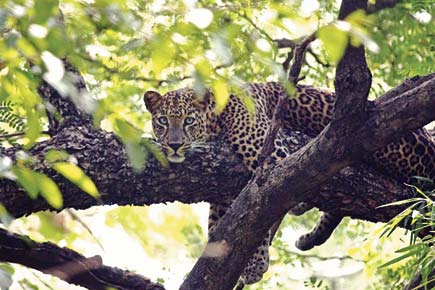A researcher from the Wildlife Institute of India has revealed data from a camera trapping exercise he had undertaken to track and identify leopards in and around the Sanjay Gandhi National Park

All the debate over the leopard population in the national park and surrounding areas has been put to rest, as the results of an expert study on the same has been disclosed. The study involved camera trapping the big cats over 45 days and was undertaken by a researcher from the Wildlife Institute of India (WII).
ADVERTISEMENT

The national park was split into three zones, each being tracked with around 15 cameras, to accurately study leopard activity there. Each leopard will be individually identified by the unique rosette patterns on the left and right flanks to ensure there is no double counting. Pic/Sachin Kalbag
Speaking to mid-day Santosh Saste, assistant conservator of forest (ACF) at the Sanjay Gandhi National Park, confirmed, “On Tuesday morning, the WII expert will make a presentation during which the number of leopards found in SGNP will be revealed.”
Principal Chief Conservator of the Forest (Western Region) Suresh Thorat, SGNP director Vikas Gupta, experts from the field including biologist Dr Vidya Athreya from the Wildlife Conservation Society-Bangalore will also be present. Mumbai-based Nikit Surve, who is pursuing a Masters degree from WII in Dehradun, had started the 45-day camera trapping at SGNP in February this year.
The estimated number of leopard population in Sanjay Gandhi National Park (SGNP) per 100 sq/km is 21 and the leopard abandunce number in SGNP in Aarey Milk colony (AMC) and other areas where camera trapping was done is 35.
The camera trap was set up within the national park, the Yeoor range, and at Aarey Milk Colony, which acts as a buffer corridor to the SGNP. Sources said that the researcher had also got images of the big cats in Aarey during the study, which indicates considerable leopard activity in the area.
Also read: Karnataka scientists estimating leopard cat population in Western Ghats
By splitting the research area into three zones and covering each with 15 cameras, the study aimed to get more accurate information about the leopard residents at SGNP, including their behaviour and movement patterns and the corridors and areas they frequent.
Each leopard that has been spotted will also be individually identified by the unique pattern of rosettes on their left and right flanks, caught on the cameras. This will ensure that no leopard is counted twice. If sources are to be believed, the number of leopards in the area could be around 20 to 35 higher than the number found during a previous study by the Mumbaikars for SGNP (MfSGNP) initiative (which had estimated 22 leopards in a 2011 project).
However, members of the earlier project caution that the two must not be compared as they were undertaken on different scales. “The MfSGNP initiative has been very helpful, as its aim was to take the basic information on leopards, their prey, conflict levels, as well as how different people view leopards, and finally to make Mumbaikars aware of all this,” said one of the researchers in the MfSGNP initiative.
 Subscribe today by clicking the link and stay updated with the latest news!" Click here!
Subscribe today by clicking the link and stay updated with the latest news!" Click here!






